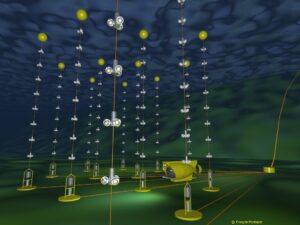In the Mediterranean Sea off the coast of southern France, a start has been made last week with the dismantling of the ANTARES neutrino telescope. The detector at a water-depth of 2.5 kilometers has been in continuous operation for sixteen years.

“It’s a strange feeling to stop looking at our own measurements when we get an alert from other observatories,” says Nikhef physicist Dorothea Samtleben, who was long associated with the project. Nikhef has been a partner in ANTARES from the beginning. It now has a leading role in KM3NeT.
Barely any interactions
ANTARES is a detector that can observe neutrinos reaching Earth from cosmic sources. Neutrinos are elementary particles with no charge and virtually no mass, which can be created in subatomic processes. They have hardly any interactions with matter, and can therefore fly from their source to an observer in the cosmos virtually unhindered. The disadvantage is that detection requires very large detectors, to find one now and then.
ANTARES consisted of twelve lines of light sensors reaching up from the seafloor in an earth-dark water cylinder about 250 meters in diameter and 500 meters high. They were sensitive to Cherenkov light, which is generated when a neutrino releases charged particles from atoms in the water.
From the signals in various spheres, traces of passing particles can be reconstructed. To distinguish neutrinos from muons from the Earth’s atmosphere, the detector looked primarily downward. Neutrinos from the cosmos can easily traverse the entire earth, muons cannot.
Galactic Core
ANTARES was developed in the 1990s, and from 2006 built 40 kilometers off the coast at La Seyne-sur-Mer in a collaboration of mainly France, the Netherlands, Italy, Germany and Spain.
The low latitude location is well suited to find sources in the Milky Way, for example the center where a black hole is suspected. In 2013, a possible signal was also found in ANTARES after a detection from the ICECUBE neutrino detector at the South Pole.
ANTARES was initially scheduled to operate until 2016, but its lifetime was extended after the first observations of gravitational waves in 2015/16 from colliding black holes in the universe. Detectors such as ANTARES and ICECUBE, as well as telescopes, search for any changes in the sky after gravity wave observations. KM3NeT also takes over that function from ANTARES.
Pioneer
ANTARES proved to be an important pioneer in the field of submarine measurement techniques for neutrino detection, and also provided a great deal of knowledge about biological processes in the deep sea. For example, the telescope was equipped with sound equipment to listen to deep-sea life.
Over the years, the collaboration published more than 90 scientific papers in journals, both on the sources of neutrinos and the properties of the particles themselves. It has also been used to search for signals of dark matter, and magnetic monopoles. Approximately one hundred PhD students from all member states conducted research with the ANTARES telescope.
